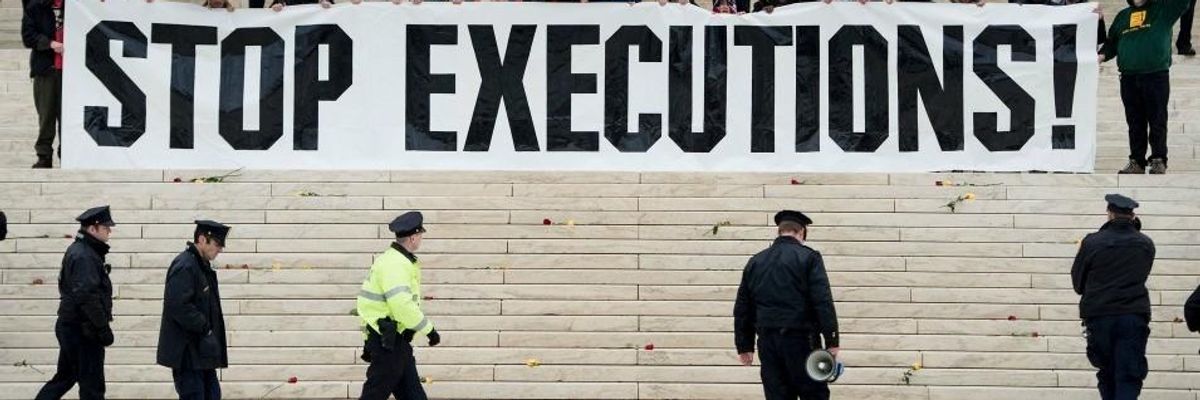
Activists hold an anti-death penalty protest in front of the U.S. Supreme Court on January 17, 2017 in Washington, D.C. (Photo: Brendan Smialowski/AFP/Getty Images)
To donate by check, phone, or other method, see our More Ways to Give page.

Activists hold an anti-death penalty protest in front of the U.S. Supreme Court on January 17, 2017 in Washington, D.C. (Photo: Brendan Smialowski/AFP/Getty Images)
"There should be no more executions in Oklahoma until we go trial in February to address the state's problematic lethal injection protocol."
\u201cThe Oklahoma DOC claims that John Grant\u2019s execution went \u201cwithout complication.\u201d Grant had full-body convulsions and vomited on himself after being injected with killing drugs. Oklahoma\u2019s lethal injection protocol causes immense suffering. This will not be covered up.\u201d— Sister Helen Prejean (@Sister Helen Prejean) 1635471863
\u201cHere\u2019s @apseanmurphy doing a better job at describing today\u2019s execution than my tweets did.\u201d— Kassie McClung (@Kassie McClung) 1635457826
Related Content

"Oklahoma knew full well that this was well within the realm of possible outcomes in a midazolam execution. It didn't care... and the Supreme Court apparently didn't either."
Grant was "failed...at every stage of his life, and then we took that from him as well," tweeted journalist Jamie A. Hughes.
Trump and Musk are on an unconstitutional rampage, aiming for virtually every corner of the federal government. These two right-wing billionaires are targeting nurses, scientists, teachers, daycare providers, judges, veterans, air traffic controllers, and nuclear safety inspectors. No one is safe. The food stamps program, Social Security, Medicare, and Medicaid are next. It’s an unprecedented disaster and a five-alarm fire, but there will be a reckoning. The people did not vote for this. The American people do not want this dystopian hellscape that hides behind claims of “efficiency.” Still, in reality, it is all a giveaway to corporate interests and the libertarian dreams of far-right oligarchs like Musk. Common Dreams is playing a vital role by reporting day and night on this orgy of corruption and greed, as well as what everyday people can do to organize and fight back. As a people-powered nonprofit news outlet, we cover issues the corporate media never will, but we can only continue with our readers’ support. |
"There should be no more executions in Oklahoma until we go trial in February to address the state's problematic lethal injection protocol."
\u201cThe Oklahoma DOC claims that John Grant\u2019s execution went \u201cwithout complication.\u201d Grant had full-body convulsions and vomited on himself after being injected with killing drugs. Oklahoma\u2019s lethal injection protocol causes immense suffering. This will not be covered up.\u201d— Sister Helen Prejean (@Sister Helen Prejean) 1635471863
\u201cHere\u2019s @apseanmurphy doing a better job at describing today\u2019s execution than my tweets did.\u201d— Kassie McClung (@Kassie McClung) 1635457826
Related Content

"Oklahoma knew full well that this was well within the realm of possible outcomes in a midazolam execution. It didn't care... and the Supreme Court apparently didn't either."
Grant was "failed...at every stage of his life, and then we took that from him as well," tweeted journalist Jamie A. Hughes.
"There should be no more executions in Oklahoma until we go trial in February to address the state's problematic lethal injection protocol."
\u201cThe Oklahoma DOC claims that John Grant\u2019s execution went \u201cwithout complication.\u201d Grant had full-body convulsions and vomited on himself after being injected with killing drugs. Oklahoma\u2019s lethal injection protocol causes immense suffering. This will not be covered up.\u201d— Sister Helen Prejean (@Sister Helen Prejean) 1635471863
\u201cHere\u2019s @apseanmurphy doing a better job at describing today\u2019s execution than my tweets did.\u201d— Kassie McClung (@Kassie McClung) 1635457826
Related Content

"Oklahoma knew full well that this was well within the realm of possible outcomes in a midazolam execution. It didn't care... and the Supreme Court apparently didn't either."
Grant was "failed...at every stage of his life, and then we took that from him as well," tweeted journalist Jamie A. Hughes.